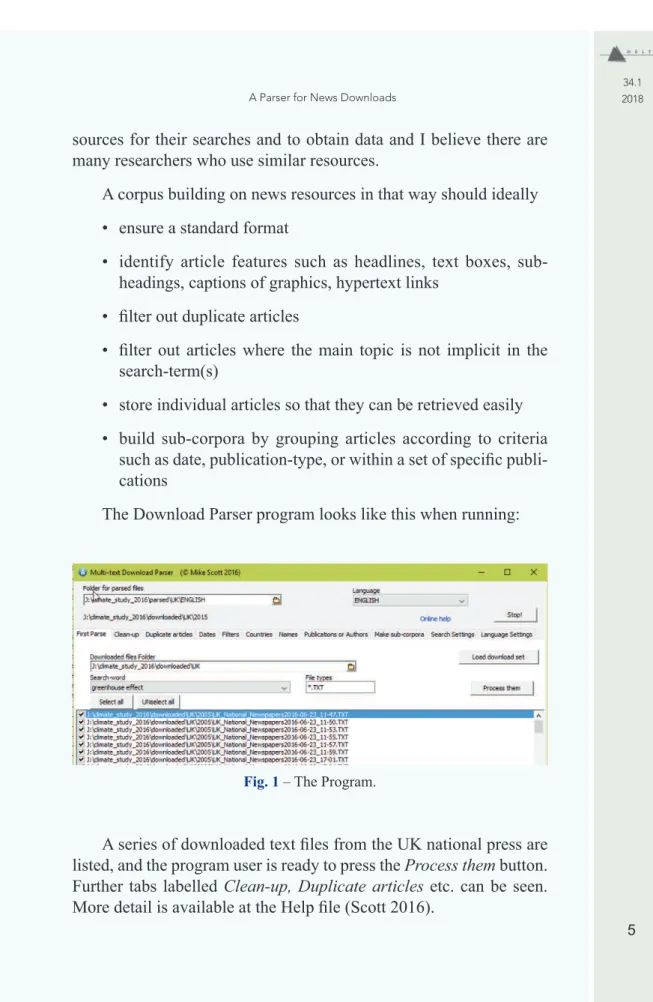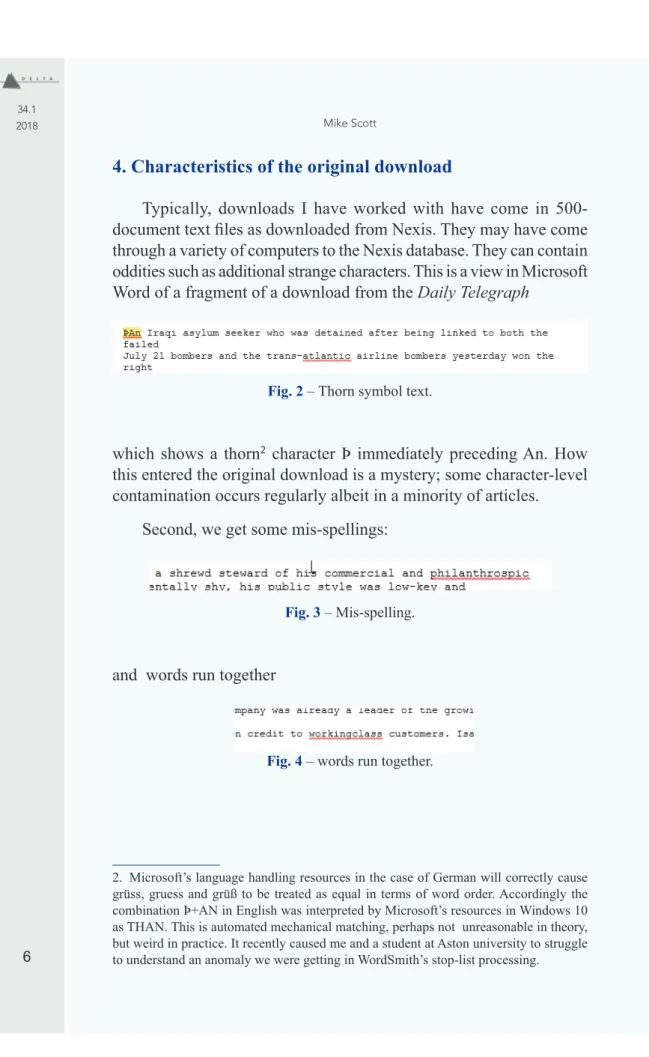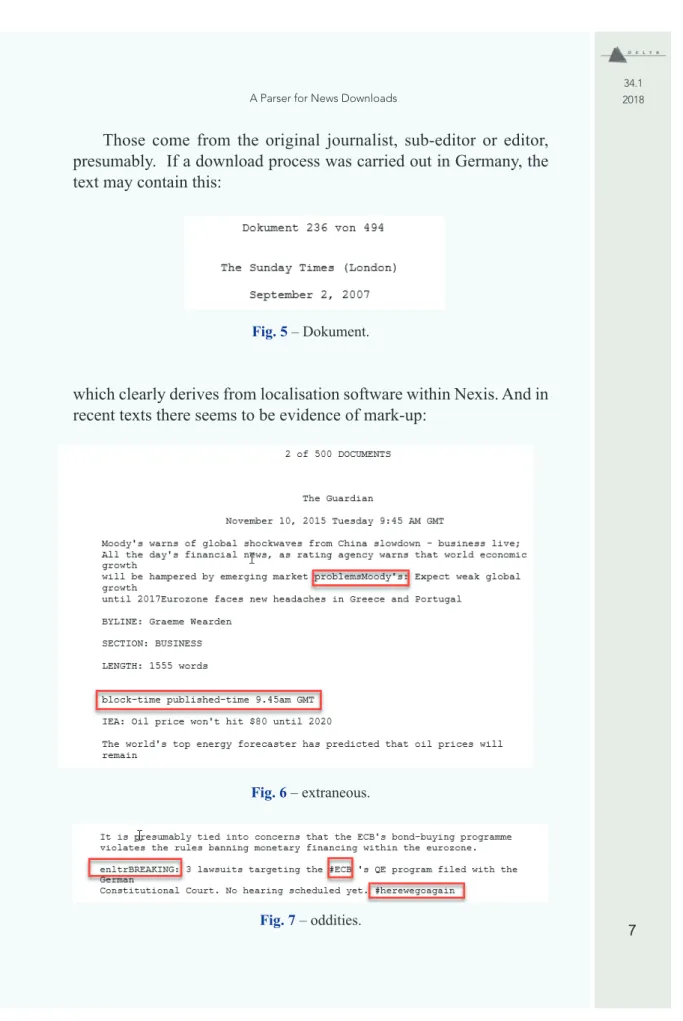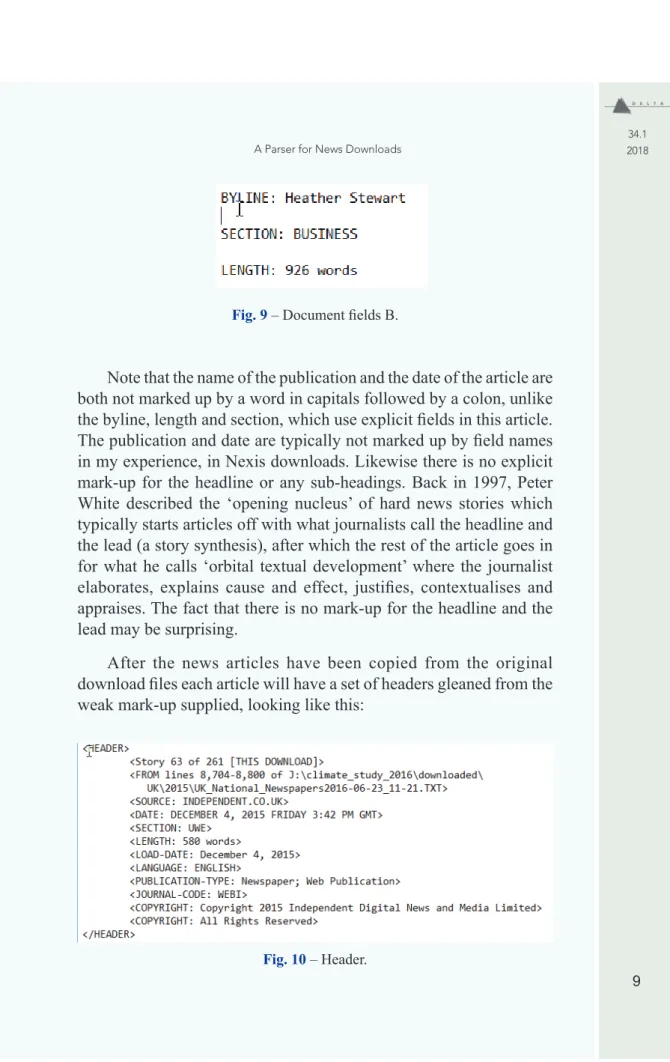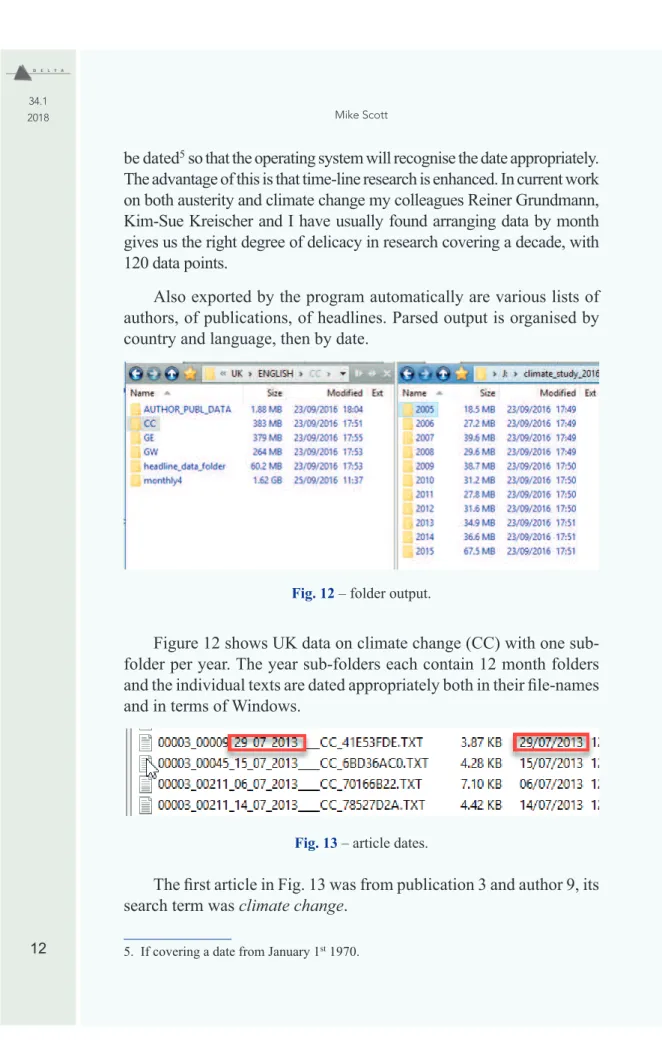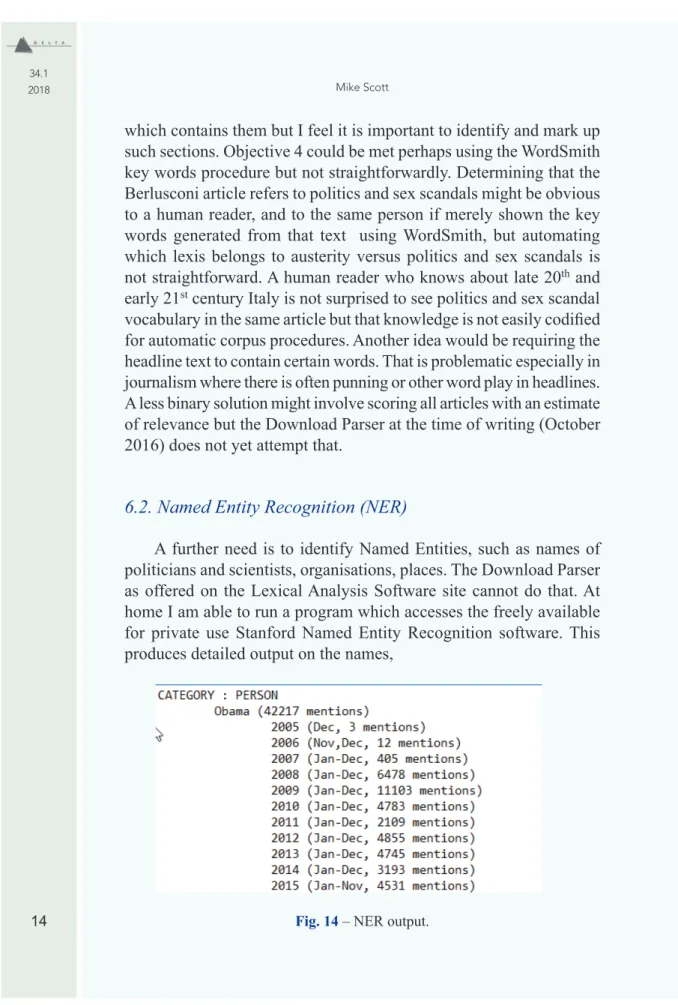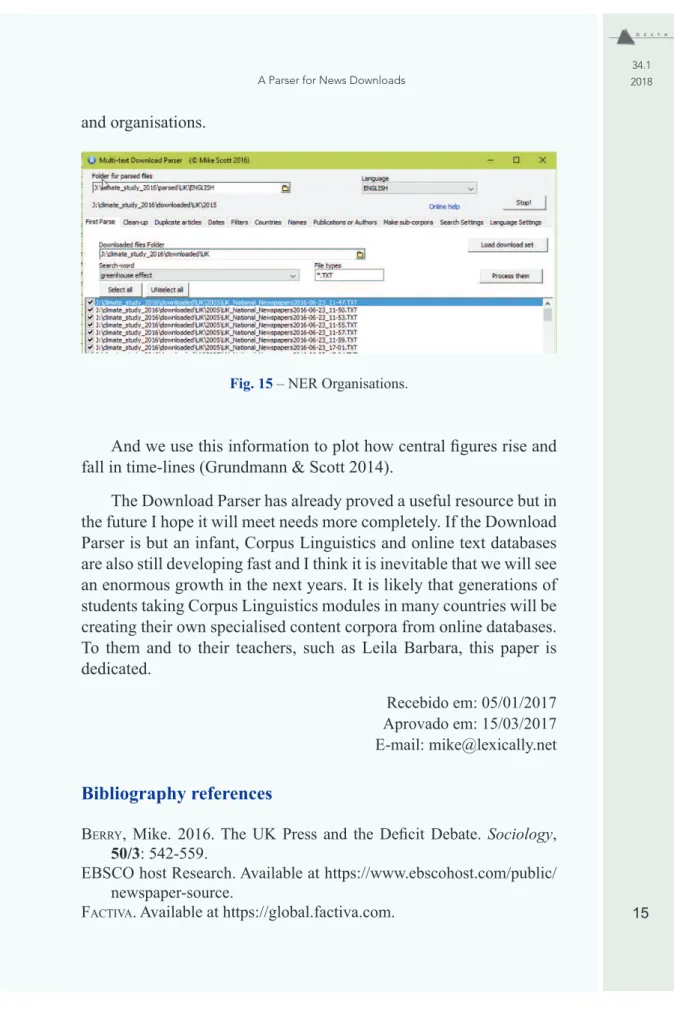This content is licensed under a Creative Commons Attribution License, which permits unrestricted use and distribution, provided the original author and source are credited.
D.E.L.T.A., 34.1, 2018 (1-16)
D E L TA
A Parser for News Downloads
Um Parser para o download de notícias
Mike SCOTT
(Aston University - School of Languages & Social Sciences - Birmingham - UK)
ABSTRACT
This paper presents the Download Parser, a tool for handling text downloads from large online databases. Many universities have access to full-text databases which allow the user to search their holdings and then view and ideally download the full text of relevant articles, but there are important problems in practice in managing such downloads, because of factors such as duplication, unevenness of formatting standards, lack of documentation. The tool under discussion was devised to parse downloads, clean them up and standardise them, identify headlines and insert suitably marked-up headers for corpus analysis.
2
RESUMO
Este artigo apresenta o Download Parser, uma ferramenta para gerenciar downloads de texto de grandes bancos de dados online. Muitas universidades têm acesso a bases de dados com textos completos que permitem ao usuário pesquisar e, em seguida, visualizar e, idealmente, baixar o texto completo de artigos relevantes. Todavia há problemas importantes na prática do gerenciamento de tais downloads, por causa de fatores como duplicação, falta de padrão de formatação e falta de documentação. A ferramenta em discussão foi concebida para analisar downloads, limpá-los e padronizá-los, identificar títulos e inserir cabeçalhos adequadamente etiquetados para análise de corpus.
Palavras-chave: Corpus de notícias; Tratamento de Corpus; Textos Duplicados; Construção de sub-corpora.
1. Introduction
The aim of this paper is to present a tool for handling text downloads from large online databases. Many universities have access to full-text databases held by organisations such as EBSCO host Research, Factiva, LexisNexis, ProQuest. These allow the subscribed user to search their holdings and then view and ideally download the full text of relevant articles. It is preferable if they allow a good number of relevant articles to be downloaded together in one text fi le. They may offer a variety of formats for the download such as plain text, PDF, Microsoft Word.
3
novices taking corpus linguistics courses and experts in various fi elds are fi nding them useful.
In this paper I will fi rst explain the problems in more depth and then outline the procedures which the software adopts to attempt a solution. The evaluation will be complemented in the Conclusions with some important limitations and ideas for desirable further development.
The paper is presented in honour of my long-time friend and ex-colleague and fellow corpus enthusiast, Leila Barbara. She has encouraged generations of her colleagues and students at the Catholic University of São Paulo to use WordSmith Tools and I am hoping she will encourage them now to take an interest in the Download Parser
software.
2. Problem
Holdings in the various databases depend on commercial agreements being signed between such online database agencies and relevant publishers such as the Guardian, Daily Mail, and their peers in many countries and in a wide range of languages. It is almost inevitable that these database agencies’ acquisition policies will favour sources from the USA and its commercial allies. Naturally the number of years of access to the full text of such resources depends on each publisher having made their news accessible in electronic format and determined to entrust them to a large database company; while many newspapers have been organised with all their text produced and formatted in-house digitally since the 1980s or earlier, not all have passed on a full run of their holdings. Moreover, the formatting which suits one newspaper or news agency cannot be expected to correspond well with that of others.
4
lexisnexis.co.uk/hubfs/Resources/Nexis_User_Guides_Advanced_ Search_Guide.pdf shows an example with two pages outlining the various choices one may make for an advanced search) but how the search operates internally in their database is not made clear. Function words get cut out so a search on “this” or “because” alone will fail, since the aim for most users will be to carry out historical or political research using content words. Accordingly such resources are not good for building a general corpus of news text. There are no options for requiring a search-term to occur more than a specifi ed number of times in each article selected, and it seems that even if a search-term occurs once only in passing, the Nexis search-engine includes it. For example, a Times article of November 10th 2015 headed “Berlusconi bounces back in rightwing pact” was retrieved in a search on the term
austerity, because it included a brief reference to Beppe Grillo, “a former comic whose anti-austerity Five-Star movement”…, although the text really concerns Berlusconi joining a coalition, hoping thereby to recover politically. The text is not about austerity, cuts, economic problems but about Italian politics.
In general, then, the problems in using these downloads are that a rather mixed bag of incompletely formatted data is obtained containing a lot of relevant articles with some duplication and including articles where the search-term is peripheral.
3. Corpus Requirements
In recent years I have been involved in research using corpus linguistic methods on topics such as climate change, austerity, energy security. An example would be Grundmann and Scott (2014), where we used Nexis and searched news sources from the USA, UK, France and Germany looking for references to global warming, climate change, greenhouse effect and translations1 in French and German. Berry (2016), Koteyko (2012) and Mercille (2014) likewise used Nexis
5
sources for their searches and to obtain data and I believe there are many researchers who use similar resources.
A corpus building on news resources in that way should ideally
• ensure a standard format
• identify article features such as headlines, text boxes, sub-headings, captions of graphics, hypertext links
• fi lter out duplicate articles
• fi lter out articles where the main topic is not implicit in the search-term(s)
• store individual articles so that they can be retrieved easily
• build sub-corpora by grouping articles according to criteria such as date, publication-type, or within a set of specifi c publi-cations
The Download Parser program looks like this when running:
Fig. 1 – The Program.
6
4. Characteristics of the original download
Typically, downloads I have worked with have come in 500-document text fi les as downloaded from Nexis. They may have come through a variety of computers to the Nexis database. They can contain oddities such as additional strange characters. This is a view in Microsoft Word of a fragment of a download from the Daily Telegraph
Fig. 2 – Thorn symbol text.
which shows a thorn2 character Þ immediately preceding An. How
this entered the original download is a mystery; some character-level contamination occurs regularly albeit in a minority of articles.
Second, we get some mis-spellings:
Fig. 3 – Mis-spelling.
and words run together
Fig. 4 – words run together.
7
Those come from the original journalist, sub-editor or editor, presumably. If a download process was carried out in Germany, the text may contain this:
Fig. 5 – Dokument.
which clearly derives from localisation software within Nexis. And in recent texts there seems to be evidence of mark-up:
Fig. 6 – extraneous.
8
These show signs of the infl uence of the web, possibly Twitter hashtags but also of unmarked internal computer mark-up.
5. Parse Process
This section describes how the downloaded plain text fi les are parsed to identify where each article begins and ends and how they are cleaned up, marked-up and sorted for corpus use.
5.1. Interpreting weak mark-up
It is not possible or desirable in this paper to explain all of the technical aspects, but essentially the program operates fi rst of all by converting all of each downloaded text to Unicode3. Then it goes through each download text looking for wording which marks the beginning of an article, such as “Document # of #”4. This wording and similar fi eld markers can be edited in the program settings so that users may use the program with their own downloads. Once it fi nds where each text begins and ends it can keep a copy of each article and parse that copy for document fi elds. An example of the fi elds which state the publication and date is in Fig 8.
Fig. 8 – Document fi elds A.
and fi elds showing the journalist’s name, the section of the newspaper and the length can be seen in Fig. 9.
9
Fig. 9 – Document fi elds B.
Note that the name of the publication and the date of the article are both not marked up by a word in capitals followed by a colon, unlike the byline, length and section, which use explicit fi elds in this article. The publication and date are typically not marked up by fi eld names in my experience, in Nexis downloads. Likewise there is no explicit mark-up for the headline or any sub-headings. Back in 1997, Peter White described the ‘opening nucleus’ of hard news stories which typically starts articles off with what journalists call the headline and the lead (a story synthesis), after which the rest of the article goes in for what he calls ‘orbital textual development’ where the journalist elaborates, explains cause and effect, justifi es, contextualises and appraises. The fact that there is no mark-up for the headline and the lead may be surprising.
After the news articles have been copied from the original download fi les each article will have a set of headers gleaned from the weak mark-up supplied, looking like this:
10
All the header lines starting with a word in capitals followed by a colon use the fi elds which were found in the article itself. All header lines are angle-bracketed so that corpus software can ignore them when handling the text alone.
A headline section follows:
Fig. 11 – Headline.
Headlines are identifi ed by seeking the end of the fi rst complete sentence (ending in a full stop, a question mark or an exclamation mark), separating out as a chunk all the text up to the end of the fi rst sentence and looking in that chunk for either a pair of line-breaks, or a break followed by several capital letters, or else the last line-break in the chunk. The headline is assumed to precede the place thus identifi ed, the fi rst sentence of the text (the lead or part of it) being the remainder.
5.2. Recoding
Cleaning up the text often requires some re-coding of the names of publications or of authors. For example the Guardian newspaper may have been labelled The Guardian (London), or Guardian Online or
11
5.3. Duplicate articles
Duplication occurs in four main ways. The same article can be retrieved in the database software if two similar search-terms are used, such as global warming and climate change. Such duplication is a simple artefact of the database search process. The other three causes of duplication can happen like this: an article gets re-published at a later date either in the same paper or elsewhere; it gets edited possibly for legal reasons; or it is re-issued for an online edition and there are editorial reasons for altering the style or length or accompanying images. A variant of the fi rst of these happens also when two journalists are each using the same newswire source and echo wording in the newswire report. Where there is a date change, this can be marked up in the database, e.g. with a LOAD-DATE fi eld.
It is easy to detect duplication where the text exactly matches or where the headers plus headlines match; computers are good at such simple matching. For the Download Parser to fi nd cases where there has been minor change, however, is trickier. It fi rst compares of the length of the two texts and if the difference is slight compares the vocabulary of the two texts taking into account each words’ length and frequency. In practice duplication works reasonably well except in a growing number of cases where an online text gets added to with comments, because of the growth in text length.
The Download Parser offers further resources for checking that all or most of the dates in the download period got covered, a useful check that the sometimes repetitive download process was carried out thoroughly, and for fi ltering the articles, requiring one or more terms to be present and copying the articles thus found to suitable folders.
5.4. Corpus Output
12
be dated5 so that the operating system will recognise the date appropriately. The advantage of this is that time-line research is enhanced. In current work on both austerity and climate change my colleagues Reiner Grundmann, Kim-Sue Kreischer and I have usually found arranging data by month gives us the right degree of delicacy in research covering a decade, with 120 data points.
Also exported by the program automatically are various lists of authors, of publications, of headlines. Parsed output is organised by country and language, then by date.
Fig. 12 – folder output.
Figure 12 shows UK data on climate change (CC) with one sub-folder per year. The year sub-sub-folders each contain 12 month sub-folders and the individual texts are dated appropriately both in their fi le-names and in terms of Windows.
Fig. 13 – article dates.
The fi rst article in Fig. 13 was from publication 3 and author 9, its search term was climate change.
13 6. Conclusion
This paper has described a program freely available for Windows computers which takes as its input a set of downloaded plain text fi les as exported by a large online database such as Nexis, and which generates a cleaned up and formatted set of articles together with the power to create further sub-corpora at will.
6.1. Limitations
There are limitations which still need to be addressed. This program has grown over the past fi ve years or so; it will continue to develop as necessary.
In the fi rst section I said the procedure should ideally:
1. ensure a standard format
2. identify article features such as headlines, text boxes, sub-headings, captions of graphics, hypertext links
3. fi lter out duplicate articles
4. fi lter out articles where the main topic is not implicit in the search-term(s)
5. store individual articles so that they can be retrieved easily
6. build sub-corpora by grouping articles according to criteria such as date, publication-type, or within a set of specifi c publi-cations
14
which contains them but I feel it is important to identify and mark up such sections. Objective 4 could be met perhaps using the WordSmith key words procedure but not straightforwardly. Determining that the Berlusconi article refers to politics and sex scandals might be obvious to a human reader, and to the same person if merely shown the key words generated from that text using WordSmith, but automating which lexis belongs to austerity versus politics and sex scandals is not straightforward. A human reader who knows about late 20th and early 21st century Italy is not surprised to see politics and sex scandal vocabulary in the same article but that knowledge is not easily codifi ed for automatic corpus procedures. Another idea would be requiring the headline text to contain certain words. That is problematic especially in journalism where there is often punning or other word play in headlines. A less binary solution might involve scoring all articles with an estimate of relevance but the Download Parser at the time of writing (October 2016) does not yet attempt that.
6.2. Named Entity Recognition (NER)
A further need is to identify Named Entities, such as names of politicians and scientists, organisations, places. The Download Parser as offered on the Lexical Analysis Software site cannot do that. At home I am able to run a program which accesses the freely available for private use Stanford Named Entity Recognition software. This produces detailed output on the names,
15
and organisations.
Fig. 15 – NER Organisations.
And we use this information to plot how central fi gures rise and fall in time-lines (Grundmann & Scott 2014).
The Download Parser has already proved a useful resource but in the future I hope it will meet needs more completely. If the Download Parser is but an infant, Corpus Linguistics and online text databases are also still developing fast and I think it is inevitable that we will see an enormous growth in the next years. It is likely that generations of students taking Corpus Linguistics modules in many countries will be creating their own specialised content corpora from online databases. To them and to their teachers, such as Leila Barbara, this paper is dedicated.
Recebido em: 05/01/2017 Aprovado em: 15/03/2017 E-mail: mike@lexically.net
Bibliography references
BERRY, Mike. 2016. The UK Press and the Defi cit Debate. Sociology,
50/3: 542-559.
EBSCO host Research. Available at https://www.ebscohost.com/public/ newspaper-source.
16
FINKEL, Jenny Rose, Trond Grenager & Christopher Manning. 2005.
Incorporating Non-local Information into Information Extraction
Systems by Gibbs Sampling. Proceedings of the 43nd Annual Meeting
of the Association for Computational Linguistics (ACL 2005): 363-370. Available at http://nlp.stanford.edu/~manning/papers/gibbscrf3. pdf.
GRUNDMANN, Reiner & Mike Scott. 2014. Disputed climate science in the
media: Do countries matter? Public Understanding of Science, Vol.
23/2: 220-235.
KOTEYKO, Nelya. 2012. Managing carbon emissions: A discursive
presentation of ‘market-driven sustainability’ in the British media.
Language and Communication. Vol. 32: 24-35.
LEXISNEXIS. Available at https://www.nexis.com/.
MERCILLE, Julien. 2014. The role of the media in fi scal consolidation
programmes: the case of Ireland. Cambridge Journal of Economics.
38: 281-300.
National Library of Australia. Available at http://trove.nla.gov.au/ newspaper/.
ProQuest. Available at http://www.proquest.com/.
SCOTT, Mike. 2016. Download Parser. Stroud: Lexical Analysis
Software. Available at <http://lexically.net/DownloadParser/> with help at <http://lexically.net/DownloadParser/HTML/index. html?introduction.html>.
STANFORD NER. Available at http://nlp.stanford.edu/software/CRF-NER.
shtml.
UNITED NATIONS DOCUMENT SYSTEM. Available at https://documents.un.org/
prod/ods.nsf/home.xsp.
WHITE, Peter R.R. 1997. ‘Death, Disruption and the Moral Order: the
Narrative Impulse in Mass-Media Hard News Reporting.’, in Genres
and Institutions: Social Processes in the Workplace and School,
Christie, F. Martin, J.R., London, Cassell: 101-133. Available at http:// www.prrwhite.info/prrwhite, 1997, Death, Disruption and the Moral Order (in news).pdf
